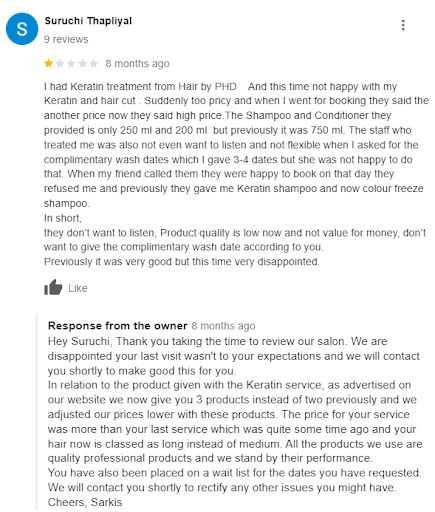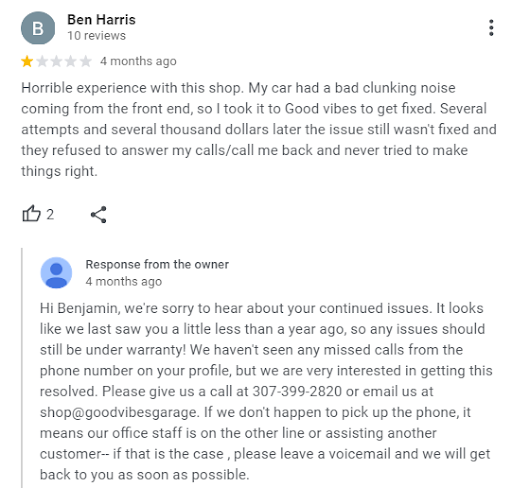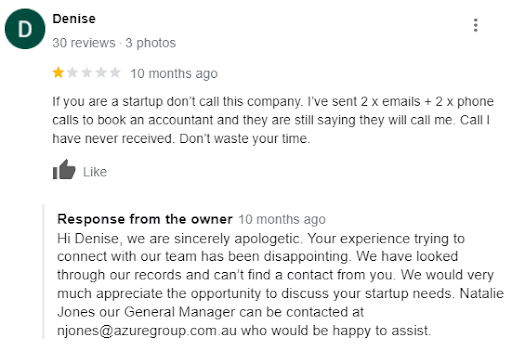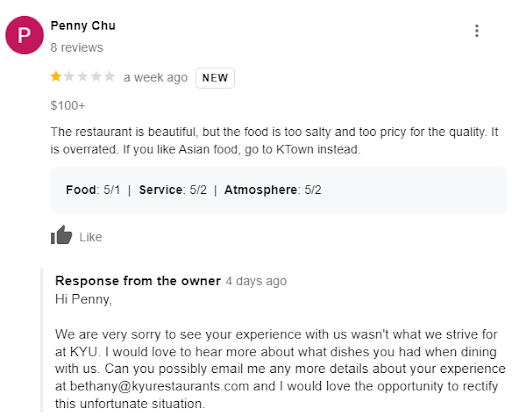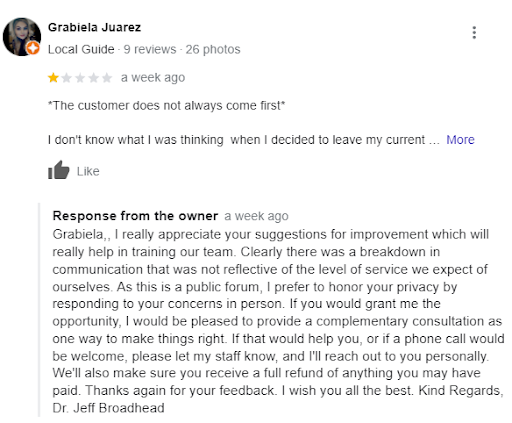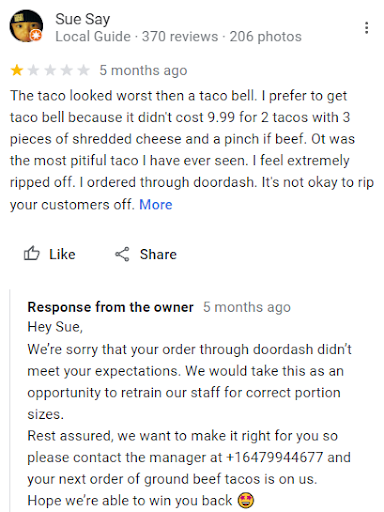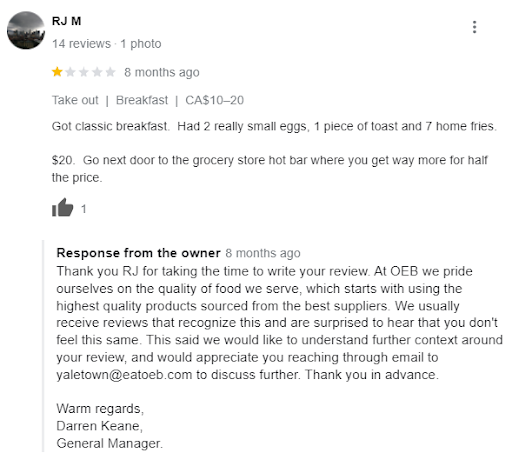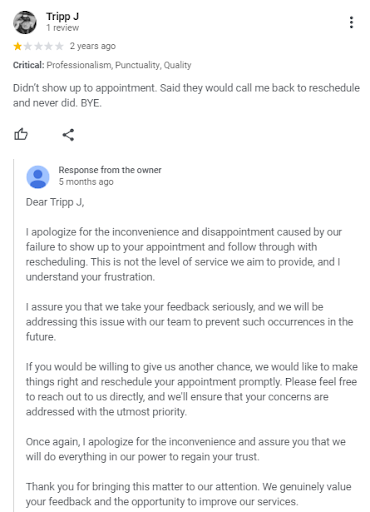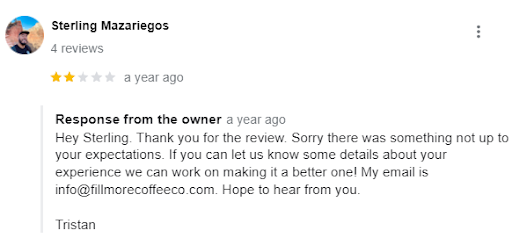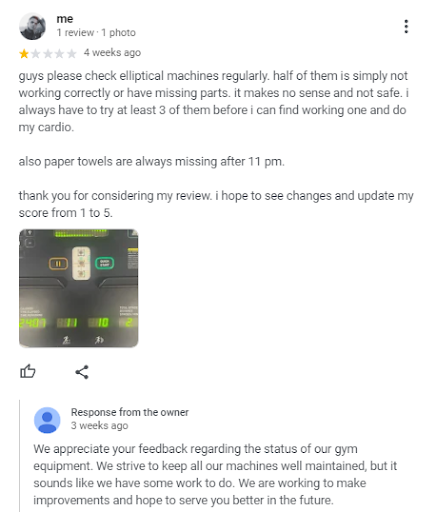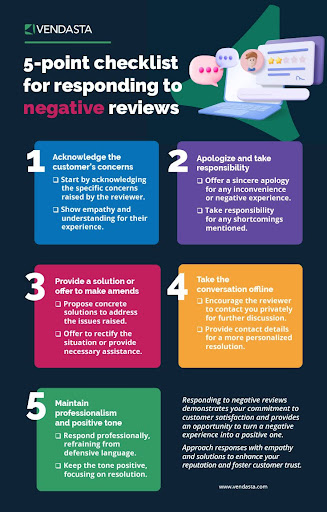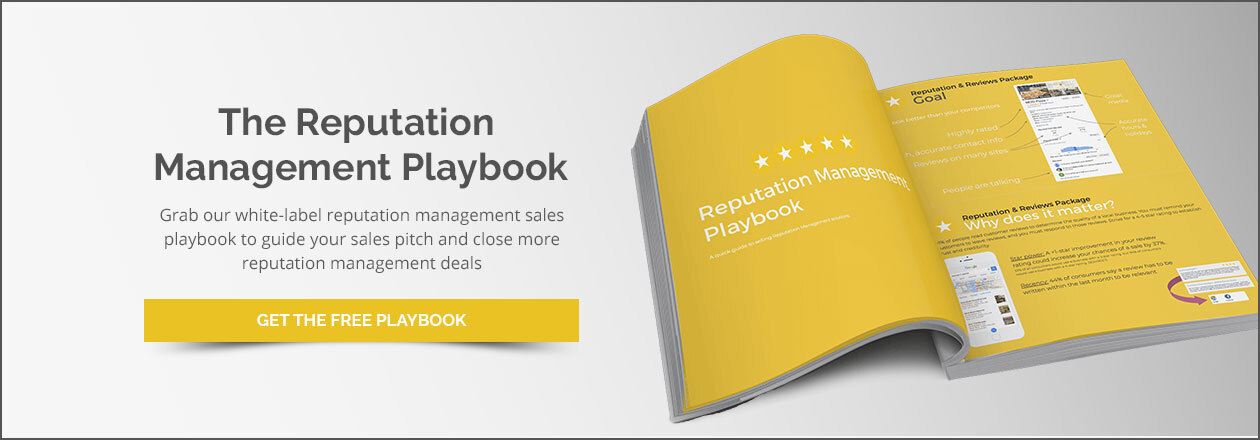Master the art of responding to negative reviews (including templates)
Negative reviews are a nightmare for small business owners, as they have the power to scare away potential customers.
Download “Why reputation management matters: A churn study” for data-based strategies on retaining clients longer using online reputation management.
The good news is that handling or responding to issues raised in negative reviews constructively can not only resolve these situations, but turn them into a powerful public relations tool. Unfortunately, many businesses struggle with reputation management due to a lack of knowledge or time constraints, so they tend to avoid dealing with bad reviews.
Marketing agencies, serving as advocates for local businesses, play a crucial role in protecting their clients’ reputation. In this guide, we'll delve into why taking a proactive approach to criticism online matters, learn from 10 negative review examples, and look at templates for effective responses.
Table of Contents
- Why responding to negative reviews is important
- 10 tips and best practices for responding to negative reviews
- 5-point checklist for responding to negative reviews
- 20 free negative review response templates
- What are the top online review platforms?
- Why consider online Reputation Management Software?
- Conclusion
Why responding to negative reviews is important
When it comes to digital reputation management, addressing negative reviews is crucial for small and medium businesses (SMB) and the agencies that support them. Let’s delve into why that is.
Reviews are a core part of the buying journey
With nearly all consumers relying on online reviews, and the majority trusting them as much as personal recommendations, public opinion significantly influences buyers. From a business perspective, the accumulation and neglect of negative reviews can act as a corrosive force, harming a business’s reputation and sales. Consider the following statistics:
- One negative review can deter 20% of potential clients.
- Three negative reviews can drive away up to 60% of customers, while four or more may scare off 70%.
- Businesses with a 1-to-1.5 star rating on Google earn 33% less than the average.
- Multiple negative reviews can diminish search traffic and rankings.
For these reasons, and those highlighted in the rest of this section, negative reviews need to be a priority within any broader reputation management and marketing strategy.
Consumer expectations
Negative reviews are expected in the business landscape, as a flawless record of exclusively positive feedback can raise suspicions. The key lies in how businesses handle criticism on platforms like Google Business Profile (GBP). Consumers often anticipate SMBs to address negative reviews promptly, and a failure to do so might imply indifference or a lack of concern for customer opinions.
Rebuilding trust
Negative reviews that aren’t handled, or handled well, erode trust. Timely and constructive responses demonstrate a commitment to addressing concerns and rebuilding confidence. Proactively seeking solutions and showcasing genuine efforts to improve can contribute to long-term trust restoration.
Customer retention
Swift and thoughtful responses can turn dissatisfied customers into loyal advocates by showcasing dedication to resolution. Offering incentives or personalized gestures in follow-up communications can solidify relationships and encourage repeat business, as demonstrated in the 10 negative review examples we will go through below.
Enhancing public perception
Publicly addressing negative reviews allows businesses to present their side of the story and show a commitment to customer satisfaction. Just think about it, consumers are scrolling through dozens of reviews. How will they perceive a business that ignores all its negative reviews, versus one that addresses each one professionally?
SEO impact
Many businesses may not know that regularly engaging with reviews, even negative ones, can positively impact their search engine optimization (SEO) efforts, leading to improved online visibility. Yep, responding to reviews - both good and bad - provides bonus SEO juice!
10 tips and best practices for responding to negative reviews
So, how to respond to negative reviews when the going gets tough? Let's delve into practical insights by examining 10 distinct negative review examples from diverse industries and situations, and walk through why their responses were effective.
1. Address the reviewer
The initial step in crafting a response to a review is to genuinely listen to the customer and comprehend their issue. This involves carefully analyzing the review and, if feasible, examining the customer's history within the business for additional context. To illustrate, consider this negative experience shared by a customer regarding a hair salon in Columbus, Ohio.
Why it works
This review is worth analyzing as it involves a sensitive and complex situation, providing the business r with the chance to share its perspective. Examining the review closely, the business owner went beyond generic terms and addressed the reviewer by her name, which is the right thing to do and comes across better than opening “dear customer.”
Additionally, the public commitment to rectify the situation and the adept navigation of the issue, including an explanation of price discrepancies, showcase the business owner's transparency and commitment to customer satisfaction.
2. Stay calm and professional
The worst response to a negative situation is to retaliate negatively against a customer. Negative reviews are bound to happen, often due to miscommunication, employee mistakes, misaligned expectations, or a customer not providing the right contact details. Staying professional is crucial, as demonstrated in this example from a mechanic shop in Laramie, Wyoming.
Why it works
In this example, the owner's response was skillfully handled. The business owner avoided blaming the customer or adopting a defensive tone regarding a potential phone number mix-up.
Instead, the response reassured the customer about possible warranty coverage, expressed a commitment to resolving the issue, and urged the customer to contact the business via a specified phone number or email, conveying that they are committed to making things right.
3. Apologize and acknowledge
A notable trend in the negative review examples shown in this blog is the tendency to apologize and acknowledge criticism, as it shows humility, empathy, and a genuine commitment to customer satisfaction on the part of business owners. This transparent approach not only helps mend the immediate situation but also fosters trust and understanding, turning dissatisfied customers into potential advocates for the business. Let’s look at how an accounting firm in Sydney, Australia handled a negative experience of a prospective customer.
Why it works
This response is effective for several reasons. Firstly, it starts with a sincere apology, acknowledging the customer's disappointment while clarifying that the business was not contacted by this potential customer. Additionally, it demonstrates a proactive approach by escalating the matter and offering the customer the contact details of the general manager.
While there's no assurance that the potential customer will take further action, the response enables the business to maintain a positive image and presents a small opportunity to potentially win back the prospect, which is better than taking no action at all.
4. Take the conversation offline
One valuable aspect of negative reviews is the insight they provide into areas that require improvement for business owners. Without such feedback, identifying areas of weakness can be challenging.
However, reviewers may sometimes provide minimal detail, and negative reviews on social media can escalate into lengthy, public exchanges. In such cases, it becomes crucial to transition the conversation offline, collaborating with the customer to find effective solutions. This negative review of a restaurant in New York City, New York, serves as an illustrative example.
Why it works
Suggesting a private discussion demonstrates respect for the customer's concerns and prevents further public escalation. In this instance, the restaurant manager addressed the reviewer by name and courteously invited her to get in touch via email.
This not only showed a willingness to understand specific concerns that the restaurant may not have known about previously. The restaurant manager also offered the opportunity to rectify the situation, which is a good look amongst potential customers viewing the interaction in the review.
5. Provide solutions
In the endeavor to regain customers after a negative experience, adopting a solutions-oriented approach is unparalleled. While apologies are appreciated, offering a tangible incentive significantly increases the likelihood of winning back customers. For instance, an optometrist in Salt Lake City, Utah, exemplifies how businesses can genuinely address concerns.
Why it works
The negative review revolves around a customer's dissatisfaction with contact lenses, a matter particularly sensitive when it comes to health-related concerns and expenses. Instead of a simple apology and refund offer, the noteworthy aspect of this response is the direct involvement of the doctor.
The doctor personally acknowledged the feedback, expressed a commitment to addressing it, and provided tangible solutions, including a full refund and a complimentary session. This proactive approach signals accountability and a genuine effort to rectify the situation, which may resonate positively with other potential viewers of the review.
6. Learn from feedback
Learning from feedback in reviews is crucial for businesses as it provides valuable insights into customer experiences, preferences, and areas for improvement. By understanding customer feedback, businesses can adapt, enhance their products or services, and tailor their strategies to meet customer expectations, ultimately fostering customer satisfaction and loyalty. Let’s look at this negative review example of a taco store in Toronto, Canada.
Why it works
This response effectively addresses the customer's dissatisfaction by acknowledging the issue, expressing apologies, and offering a proactive solution. The business not only takes responsibility for the problem but also demonstrates a commitment to improvement by mentioning staff retraining. The invitation to contact the manager for a complimentary replacement order adds a personal touch, showing a genuine effort to make amends and win back the customer's trust.
7. Showcase positive aspects
Even within the realm of negative reviews, it's crucial for businesses to highlight positive aspects of their services. This strategic approach allows businesses to counterbalance the impact of negative feedback and present a more well-rounded perspective to potential customers. To illustrate, let's delve into a review of a breakfast bistro in Vancouver, Canada.
Why it works
This business response acknowledges the customer's feedback, emphasizing the restaurant's commitment to quality with positive language about their usual recognition for excellence. The invitation to further discuss via email reflects a proactive approach, demonstrating genuine interest in understanding and resolving the customer's concerns privately. Overall, it conveys the business owner's commitment to quality produce and a sincere effort to comprehend the customer's issues in detail.
8. Show urgency
Addressing negative reviews promptly and with urgency is essential for multiple reasons. Firstly, it signals to the reviewer and potential customers that the business is actively involved and values customer satisfaction. Timely responses underscore a commitment to resolving issues swiftly, minimizing the impact of the negative review. An example of an appliance repair store in Los Angeles, California, illustrates this proactive approach.
Why it works
This response is effective as it promptly acknowledges the issue, offers a sincere apology, and outlines concrete steps to address the problem quickly. Keywords in the response such as “reschedule your appointment promptly” and “ensure your concerns are addressed with the utmost priority” convey that the business is committed to swiftly and genuinely rectifying the situation for the customer.
9. Encourage further communication
Receiving a negative review without any context or explanation can be frustrating. On platforms like Google, reviewers have the option to leave only a star rating. In the case of a low score, it's crucial for business owners to go the extra mile to understand the reasons behind it. Let's explore such a negative review example for a coffee shop based in Phoenix, Arizona.
Why it works
This response stands out as a good demonstration of going above and beyond. Although a customer had a negative experience at the coffee shop, they chose not to provide details behind the two-star review.
Rather than letting the review linger without context, the business owner took a proactive approach. They addressed the customer by name, expressed apologies for the negative experience, and extended an invitation to email the owner for further details.
While there's no certainty that the customer will reach out, the primary goal is to safeguard the store's reputation. The noteworthy aspect here is the business owner's demonstration of care, contrasting with the reviewer's lack of effort to provide information.
10. Monitor and Learn:
Monitoring and learning from feedback in negative reviews is crucial for businesses as it.
provides valuable insights into customer perceptions and areas for improvement. Regularly analyzing this feedback helps identify patterns, address recurring issues, and adapt business practices to better meet customer expectations. The following example of a gym in Portland, Oregon, demonstrates a business owner who acknowledges the need for improvement.
Why it works
The response acknowledges the need for improvement, showing accountability and a customer-focused approach. It invites future positive interactions by valuing the customer's feedback and making efforts to enhance their experience. This approach builds trust and demonstrates responsiveness to customer needs and concerns.
5-point checklist for responding to negative reviews
20 free negative review response templates
Responding to customer reviews is an art, and for business owners, it can be a challenging canvas to navigate. Crafting responses that effectively cover all the bases of a good reply is no small feat. Now, let's dive into the art of turning negatives into positives.
Below, we've crafted response templates to help you gracefully navigate those 1-4 star critiques and transform them into opportunities for improvement and customer satisfaction. These templates span various industries across 20 different situations, offering you versatile solutions. Take a look and find inspiration for your own responses:
Travel and tourism
Scenario 1 - Unpleasant hotel stay:
Review: "I stayed at this hotel, and it was a terrible experience. The room was dirty, and the service was poor."
Response: "Dear [Reviewer], we apologize for your unpleasant stay at our hotel. We take cleanliness and service seriously and are sorry for the inconvenience. We will investigate and make improvements. As a gesture, we would like to offer you a complimentary night's stay. Please get in touch with us at [Insert Contact Details] and we will make this right for you. Thank you for your valuable feedback."
Scenario 2 - Booking complications:
Review: "I had a terrible time trying to book a room. The process was confusing, and the staff were unhelpful."
Response: "Dear [Reviewer], we're sorry for the difficulty you faced in booking. We would greatly appreciate it if you get in touch at [Insert Contact Details] so we can better understand your feedback and approve. As an apology, we offer a discounted rate on your next stay. Your feedback is appreciated."
Technology and gadgets
Scenario 3 - Defective gadget:
Review: "I purchased a new toy for my child, and it turned out to be defective. Really disappointed with the quality."
Response: "Dear [Reviewer], we apologize for the defective gadget. We take product quality seriously and will investigate and improve our quality control. Please contact us for a replacement or refund. Your feedback is valuable."
Scenario 4 - Poor customer support:
Review: "Contacted customer support, but they were unhelpful and rude. Not satisfied with the service."
Response: "Dear [Reviewer], we're sorry for the poor support experience. We value your satisfaction and will review and improve our support team. As an apology, we offer you a discount on your next purchase. Thank you for your feedback."
E-commerce (General)
Scenario 5 - Late delivery:
Review: "Ordered a new watch, and it arrived much later than expected. Disappointed with the delay."
Response: "Dear [Reviewer], we apologize for the late delivery. We understand the frustration and will review our shipping process. As an apology, we offer you free shipping on your next order. Your feedback is appreciated."
Scenario 6 - Product quality concerns:
Review: "Received my new shaver, and the quality doesn't match the description. Not satisfied with the purchase."
Response: "Dear [Reviewer], we apologize for the quality mismatch. We take this seriously and will review our product descriptions. Please contact us for a return or replacement. Your feedback helps us improve."
Event planning
Scenario 7 - Poor event organization:
Review: "We used this company to host an in-person team off-site. While the event ran smoothly, our employees were shocked with the food. In particular, with the freshness and lack of options such as gluten-free and vegan (which we requested), so a couple of us went hungry for much of the day.”
Response: "Dear [Reviewer], we are delighted we could help you run a smooth team off-site, but we are disappointed to hear that the food fell short of the mark. We are sorry for this, and are taking steps to replace our caterer and will ensure we don’t miss special dietary requirements in future.
To make it up to you and your employees, we would be happy to deliver samples of gourmet products from our new caterer for your team to your office, so you can be sure that we've stepped up on the quality ahead of your next event. If you would like that, please get in touch with our event manager and we will make it happen.”
Scenario 8 - Communication issues:
Review: "Had trouble communicating details for my event. Lack of responsiveness and coordination."
Response: "Dear [Reviewer], we apologize for the communication issues. We value your feedback and will improve our coordination. Please contact us for assistance, and we offer you a discount on your next event planning. Thank you for bringing this to our attention."
Fitness and wellness
Scenario 9 - Unprofessional trainer:
Review: "My fitness trainer was unprofessional and lacked expertise. Turned up late, didn’t have my fitness plan, and ended the session in a rush. Didn't get the expected guidance."
Response: "Dear [Reviewer], we sincerely apologize for the unprofessionalism. We take trainer qualifications and their etiquette seriously, and will pass this feedback on to them. Your feedback helps us maintain quality standards.Please get in touch with us at [Insert Contact Details] for a complimentary session with a senior trainer and we’ll make sure we get you on track with your fitness goals.”
Scenario 10 - Facility cleanliness concerns:
Review: "The fitness facility was not clean and well-maintained. It's affecting my workout experience."
Response: "Dear [Reviewer], we apologize for the cleanliness concerns. We take facility maintenance seriously and will improve our standards. As a gesture of goodwill, we’d like to offer you a complimentary month of membership. We will apply this to your account the next time you come in - just let the front desk know. Thank you.”
Insurance services
Scenario 11 - Claim denial frustration:
Review: "Filed a claim with this insurance company, and it got denied without clear explanations. Did the assessor even look at the information provided? Frustrating experience."
Response: "Dear [Reviewer], we apologize for the frustration caused by the claim denial. We understand the importance of clarity and will review our communication. Please contact our claims department at [Insert Contact Details] with your case number and we will ensure the claim undergoes a second review, with a detailed explanation of the outcome.”
Scenario 12 - Premium increase concerns:
Review: "Received a sudden increase in premiums without prior notice. Unhappy with the unexpected cost."
Response: "Dear [Reviewer], we apologize for the unexpected premium increase. Unfortunately, due to human error, not all our members received the notification of an increase. We have reviewed our communication practices to ensure this doesn’t happen again. As a gesture of goodwill, we are deferring the premium increase till next month and will refund the difference between the new and old prices for this month by [Insert Date]. Your feedback is appreciated."
Home renovation
Scenario 13 - Delayed project completion:
Review: "Hired this home renovation service, and the project completion was delayed significantly. Not happy with the timeline."
Response: "Dear [Reviewer], we understand the importance of timely service and will review our project management framework. To make it up to you, we would like to give you a discount on your next project. We have made a note of this on your account, and hope that you will choose us for your future home improvement endeavors.”
Scenario 14 - Quality of workmanship:
Review: "Not satisfied with the quality of workmanship in my home renovation. Issues with attention to detail."
Response: "Dear [Reviewer], we apologize for the dissatisfaction with our workmanship. We take quality seriously and will review our processes. Please contact us for any necessary corrections. Your feedback helps us improve."
Pet services
Scenario 15 - Pet grooming disappointment:
Review: "Took my dachshund for grooming, and the results were disappointing. The service didn't meet expectations."
Response: "Dear [Reviewer], we apologize for the disappointment with our grooming service. We will review our procedures to improve, and will get in touch shortly to book your dachshund in to fix the job we did, and also offer you a free dog toy to make it up to you and your pup. Your feedback is appreciated."
Scenario 16 - Booking confusion:
Review: "Experienced confusion with booking pet sitting services. The process was unclear and caused inconvenience."
Response: "Dear [Reviewer], we apologize for the confusion with booking pet sitting services. We value your convenience and will review our booking procedures. As an apology, we offer you a discounted rate on your next booking. Your feedback is important to us."
Online learning platforms
Scenario 17 - Technical glitches in courses:
Review: "Encountered frequent technical glitches while using this online learning platform. It affected my learning experience."
Response: "Dear [Reviewer], we apologize for the technical glitches in our courses. We understand the importance of a smooth learning experience and will review our platform's functionality. As a gesture, we offer you free access to an additional course. Please get in touch at [Insert Contact Details] and we will apply this to your account. Your feedback is valuable."
Scenario 18 - Lack of course variety:
Review: "Not satisfied with the limited variety of courses available on this platform. It didn't meet my learning needs."
Response: "Dear [Reviewer], we apologize for the limited course variety. We take your learning needs seriously and will review and expand our course offerings. As an apology, we offer you a discounted rate on your next course. Your feedback helps us enhance our platform."
Environmental services
Scenario 19 - Waste disposal complaint:
Review: "Hired this waste collection company to clean out my house so I can put it on sale. I clearly told them what needed to be disposed of and laid out the items clearly in my front yard, which now looks like a complete mess. Disappointed with the service."
Response: "Dear [Reviewer], we apologize for the disappointment with our waste disposal service. We messed up, and will get in touch with you immediately to rectify the situation and ensure your yard is cleaned up promptly and also provide a partial refund. Sorry again and we look forward to making this up to you.”
Scenario 20 - Communication lapses:
Review: "Experienced lapses in communication with this environmental service. It affected the coordination of eco-friendly initiatives."
Response: "Dear [Reviewer], we apologize for the communication lapses. We understand the importance of coordination for eco-friendly initiatives and will improve our communication channels. As an apology, we offer you a discounted rate on your next environmentally friendly project. Your feedback is important to us."
What are the top online review platforms?
So which platforms are worthwhile for agencies and their customers for their digital reputation management endeavors? The following is a quick guide on the most popular platforms when it comes to reviews.
- Google Reviews: Widely used and integrated with search results, making it a significant player in various industries.
- Yelp: A pioneer in the review space, particularly influential for restaurants and local services.
- Trustpilot: Offers a global platform for customer feedback, catering to diverse industries.
- TripAdvisor: Dominant in the travel industry, providing a specialized platform for user reviews.
- G2: Focused on software reviews, offering insights into the performance of different solutions.
- Facebook Reviews: Tied to the social media giant, it serves as a familiar space for customer commentary.
However, a new trend is emerging with the rise of vertical-specific review websites. From fitness professionals to doctors and car dealers, platforms tailored to specific industries collect more detailed and granular information.
Agencies should explore these platforms to enhance their clients' online presence. For a comprehensive list, check out 40 awesome review sites to fuel your business growth.
Why consider online Reputation Management Software?
Managing online reputation manually can be overwhelming when a reputation management action plan kicks into full gear. It's easy to miss responses, lose a consistent voice, overlook SEO optimization, and face a full-time job handling numerous reviews across platforms. Agencies can enhance efficiency by leveraging reputation management software.
Partnering with Vendasta allows agencies to resell AI-powered review management software, improving search rankings, enhancing customer acquisition, and streamlining response efficiency for all local business clients. Beyond offering exceptional software, we also provide insights into effective pricing strategies. Explore our recommendations on how to price your reputation management services here.
Conclusion
In the realm of customer feedback, responding strategically is an art that demands finesse, whether they’re negative or positive reviews. Navigating the delicate balance between addressing negative feedback and enhancing customer satisfaction is no easy task for business owners. However, armed with carefully crafted response templates covering diverse industries, the process becomes more manageable.
These templates serve as beacons, guiding businesses to gracefully transform 1-star critiques into opportunities for improvement. With a commitment to continuous enhancement, these responses not only resolve immediate concerns but also build a foundation for lasting customer relationships. As businesses embrace this art, they can turn the challenge of reviews into a canvas for positive transformation.


